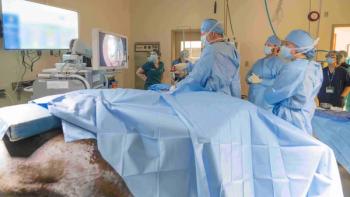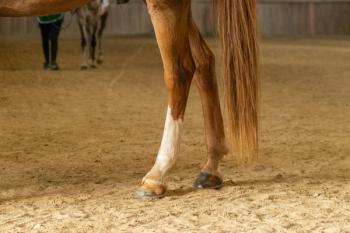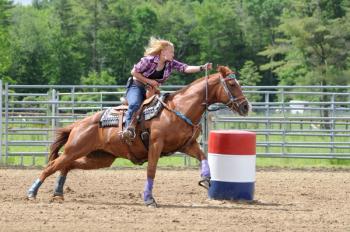
Equine musculoskeletal trauma: Assessment and stabilization (Proceedings)
Types of musculoskeletal trauma: wounds and lacerations, skin, deep structures (tendon, ligament, joint, bone), vascular injury, nerve injury, fracture.
Types of musculoskeletal trauma
• Wounds and lacerations
• Skin
• Deep structures (tendon, ligament, joint, bone)
• Vascular injury
• Nerve injury
• Fracture
Patient assessment
• Horses may be frantic and distressed following trauma
• Use appropriate restraint to keep you and your patient safe during assessment
• Use sedation
o Most equine sedatives also provide analgesia as well as provide chemical restraint
o Will decrease horse's anxiety for thorough assessment
• Anatomy
o Knowledge of anatomy is critical to appropriate assessment
o Appropriate identification of affected structures
o Determines necessity of immediate treatment
o Will dictate method of stabilization for transport
o Anatomic relationships very important
• Integument
• Muscle
• Vascular and nerve
• Tendon/ligament
• Synovial structures: joints, tendon sheaths, bursa
• Bone
o Location, location, location
• Small wounds in the wrong location can be life-threatening
• Based on location some fractures cannot be repaired
Integument
• Lacerations and wounds
o When involving only the skin, subcutaneous tissue and fascia they usually will heal well
o Some may require extensive wound care management long term
• Burns
o As in human burn patients these require extensive management locally and systemically
Muscle
• Muscle damage is confined to the areas above the carpus and tarsus
• Not necessarily life or performance threatening unless extensive
• Myositis can be a bigger concern than direct trauma
o Clostridial Myositis
Vascular injury
• Laceration of large vessels can result in exsanguination
• Damage to major blood supply to the limb can result in loss of the limb – either by transection or blunt trauma
Nerve injury
• Loss of sensation
o Can return over time
• Loss of function
o Can lose function of a limb which is life-threatening
• Examples: suprascapular, radial, or femoral nerve paralysis
Tendons and ligaments
• Major supporting structures of the lower limb
• Injury can be life and performance threatening
• Transection of the major tendons and ligaments can have a diagnostic stance when weight bearing
o Deep digital flexor tendon
• Toe flips up
o Superficial digital flexor tendon
• Fetlock drops slightly or can appear normal
o Suspensory ligament
• Fetlock drops
o Extensor tendons
• Cannot extend the digit
• Catches toe and "knuckles over" at the fetlock
• Transection results in loss of stability of joints and other soft tissue structures
o Severe injury can result in joint dislocation
o They can look like horses with a fracture
Synovial structures
• Contamination of synovial structures can be life threatening
• Sepsis can be refractory to treatment
o Causes severe lameness due to synovitis and infection
• Many synovial structures are superficial and easily penetrated
Bone
• Fracture
o Complete or incomplete
o Stress fracture
o Greenstick fracture
o Open or closed
o Simple, slab, or comminuted
• Disruption of periosteum
o Risk of sequestrum formation
Injury assessment
• Palpation
o Identify damaged structures
o Feel for
• Crepitus
• Bone fragments
• Synovial structure involvement
• Tendon / ligament involvement
• Joint instability
o Always clean and lavage wounds prior to palpation
o Clip if possible
• Radiographs
o Bone damage
o Fractures
o Luxation / dislocation
o Can be used to assess soft tissue injury
• Contrast studies
• Position of probe in relation to other structures
• Presence of gas in synovial structures
• Synovial centesis and joint distention if wound is over a joint
o Used to evaluate if a joint is involved
o You don't need to have a lab to assess joint fluid
o Fluid appearance:
• Pale yellow
• Viscous
• Clear with no turbidity
o Abnormal fluid indicates inflammation or sepsis
o Procedure:
• Sterile prep of the synovial structure at a site distant from the wound
• Insert needle into synovial cavity and aspirate fluid
• Depending on structure you may not get fluid back
• Distend synovial structure with sterile fluids (20-60 ml)
• Watch wound to see if fluid comes out the wound
• Fluid escape = synovial involvement
• Can now do a limited lavage of synovial cavity
• Inject antibiotics before removing needle.
• Ultrasound
o Used to evaluate damage to soft tissue structures
o May identify foreign body
o Evaluate synovial and other body cavity fluid for signs of inflammation or sepsis
Stabilization of musculoskeletal injuries
• Don't forget to assess the whole animal – not just the most obvious issue
o Systemic issues such as shock and dehydration may need to be addressed before stabilization of musculoskeletal trauma
o Address the most life-threatening injuries first
• Severe hemorrhage
• Compression bandage
o Unstable fractures or soft tissue injuries
• Splinting
• Compression bandage
o Very important component of musculoskeletal stabilization
o Used to:
• Stop hemorrhage
• Decrease or minimize swelling
• Protect wounds
• Stabilize fractures and severe soft tissue injury
o Components
• Non-stick pad (Telfa, Release, Adaptec)
• Gauze sponges
• Kling roll (soft white cotton roll)
• Heavy padded bandage
• Brown gauze
• Vetrap
• Elastikon
o Preparation
• Clean any wounds
• If heavily contaminated place a wet-to-dry until transported for repair
• Wear gloves until wound is covered
• Especially important if open synovial structure or open fracture
Immobilization
• Immobilization objectives
• Prevent further damage
o Soft tissue
o Nerves
o Vessels
o Bone ends
o If closed fracture – to prevent it from becoming open
o Decrease contamination
o Stabilizing limb decreases horse's anxiety
• Splint materials
o Wood boards
o PVC pipe
o Metal
o Casting material
o Be creative!!!
o Essentials:
• Must be stiff and long enough for appropriate use
• Always place over padded bandage (e.g. Robert-Jones)
• Immobilization Principles
o ALWAYS incorporate the joint above and below the fracture in splint
o NEVER end a splint at the fracture site
• Dorsal splint
o Used in front limb
o Fractures and soft tissue injuries distal to the fetlock
o Want to keep metacarpus and phalanges in dorsal alignment to prevent further disruption of the fracture
o Examples: P1 and P2 fractures, DDFT transection in pastern region
• Full limb lateral splint (front limb)
o Used in front limb
o Fractures of carpus and distal radius
o Use in proximal radius fractures in controversial
• Plantar splint
o Same principles as dorsal front limb splint
o Fractures and soft tissue injuries distal to the fetlock
o Want to keep metacarpus and phalanges in dorsal alignment to prevent further disruption of the fracture
• Full limb lateral splint – hind limb
o Used in tibia fractures
o Combine with plantar splint for fractures / dislocations of the tarsus
• Kimzey splint
o Manufactured by Kimzey Welding Works
o Used for:
• Fractures of distal cannon bone and distal limb
• Severe soft tissue trauma resulting in instability
o Keeps limb in appropriate alignment
• Casting material splint
• PVC splint
o Use 6 – 8" diameter pipe
o Cut into 3 – 4 "wide strips of appropriate length
o Can be bent with heat
Additional treatments
• Analgesia
• NSAIDS
• Low doses of sedation can also be given
o Be careful not to give too much as it may make them unstable on their feet
• Antibiotics (systemic)
o Severely contaminated wounds
o Synovial structure involvement
o Fracture
o Burns
• IV Fluids
o If in shock
o Significant blood loss
o Significant dehydration
Newsletter
From exam room tips to practice management insights, get trusted veterinary news delivered straight to your inbox—subscribe to dvm360.




